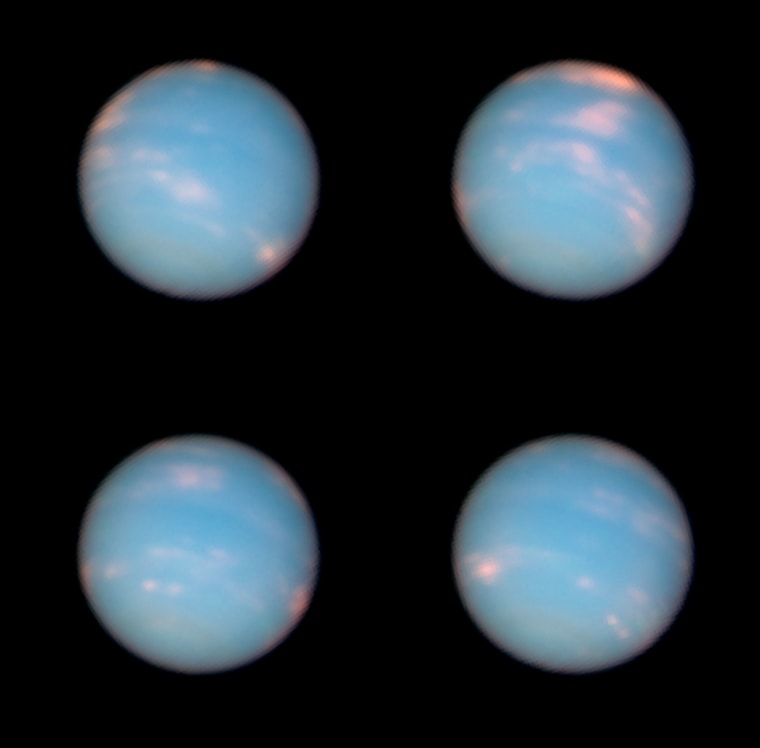For Earthlings, it’s been nearly 165 years since Neptune was found in 1846, "at the point of a pen." But for Neptune, it’s been just one circuit around the sun. To mark the first Neptunian anniversary of the discovery, the Hubble Space Telescope is releasing these latest views of the blue-green ice giant.
Hubble's near-infrared views, taken with the Wide Field Camera 3 on June 25-26, highlight the planet's pinkish high-altitude clouds of methane ice crystals, streaked throughout the predominantly hydrogen-helium atmosphere. These four pictures were taken four hours apart, providing full coverage of the eighth big rock from the sun as it turns through its 16-hour day.
Because Neptune is tilted 29 degrees on its axis, it has seasons analogous to Earth's — but because Neptune's year lasts 164.8 Earth years, each of its four seasons lasts about 40 years. Right now it's early summer in the southern hemisphere, and winter in the north. These pictures indicate that the cloud activity is shifting from south to north, apparently due to the seasonal change.
Today's image advisory from the Space Telescope Science Institute draws attention to the faint dark band near the bottom of the southern hemisphere, which is probably caused by a decrease in hazes in the atmosphere that scatter blue light. The band may be linked to high-velocity winds that sweep around that near-polar region.
The planet's turbulent weather is thought to be due to the significant difference between Neptune's strong internal heat source and its chilly cloud tops.
Neptune's history is as peculiar as its weather: It was first identified by the French mathematician Urbain Le Verrier, who figured out that something big had to be causing the gravitational perturbations that astronomers were seeing in Uranus' orbit. British mathematician John Couch Adams was also rushing to pinpoint the mysterious planet's location — but Le Verrier won the race and sent the predicted location to an astronomer at the Berlin Observatory, Johann Gottfried Galle. On the night of Sept. 23-24, 1846, Galle found Neptune and reported to Le Verrier that "the planet whose position you indicated really exists." That led Francois Arago, director of the Paris Observatory, to hail Le Verrier as "the man who discovered a planet with the point of his pen."
The discovery made Neptune, which orbits the sun at a distance of 2.8 billion miles (4.5 billion kilometers, or 30 times Earth's distance), the farthest-out known object in the solar system.
Le Verrier's success led others to predict that other planets would be found on the rim of our solar system, as detailed in my book, "The Case for Pluto." Following up on such predictions, Lowell Observatory astronomer Clyde Tombaugh discovered Pluto in 1930, just a little more than half a Neptunian year after Le Verrier. It turned out that the predictions pointing to Pluto were actually based on inaccurate data, and that Pluto was much smaller than it was initially thought to be — so small, in fact, that some people questioned whether it should be considered a planet at all.
Today, after the passage of another Neptunian half-year, the planetary picture has become a lot more complex: Astronomers now suspect that there are hundreds of dwarf planets similar to Pluto on the solar system's edge. Could there also be a "Planet X," as big as Neptune but hundreds of times farther out? It's unlikely, but not impossible. The one-year Neptunian anniversary serves as a reminder that you can't discover anything unless you keep looking.
More about the solar system's frontier:
- Observations suggest comet hit Neptune 200 years ago
- Pluto debate is about more than one little world
- The outer solar system remains mysterious
- Join the online search for icy worlds
- Interactive: The new solar system
Connect with the Cosmic Log community by "liking" the log's Facebook page or following @b0yle on Twitter. You can also check out "The Case for Pluto," Alan's book about the controversial dwarf planet and the search for new worlds.
